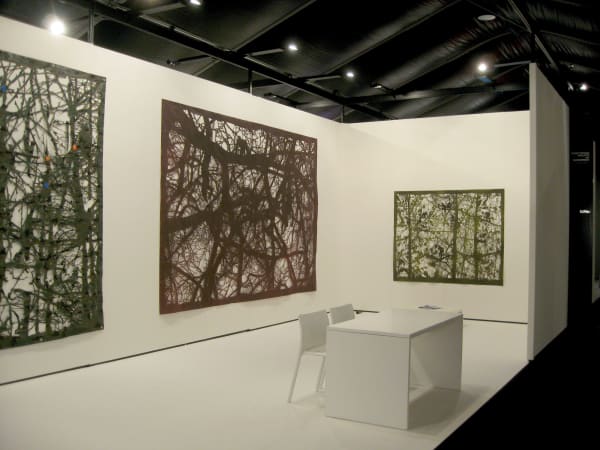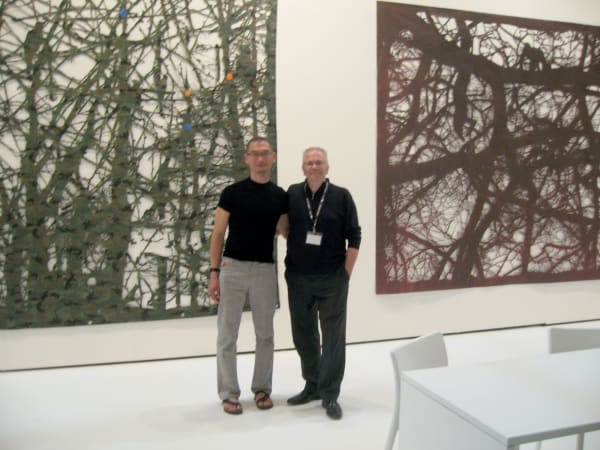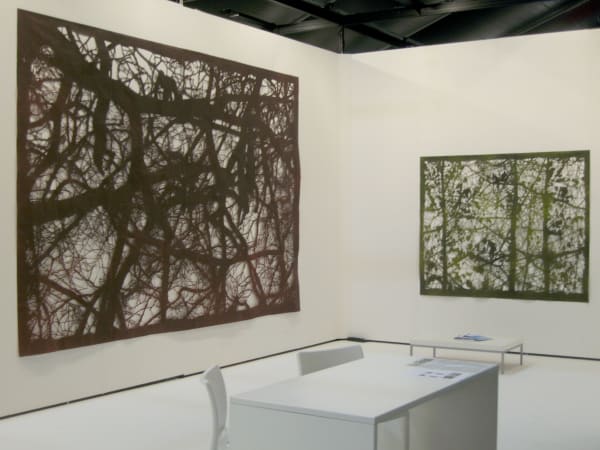June 7-10 2007
Pierre-François Ouellette art contemporain is pleased to announce a new exhibition of paper-cuts by artist Ed Pien, presented at the inaugural edition of Cornice art fair, Venice. Cornice is a new contemporary art fair that runs concurrently with the 52nd International Art Exhibition of the Venice Biennale. The fair is open to the public from June 7 - 10. If you will be in Venice during the fair we invite you to visit us at booth B6. The official Cornice website, which contains specific information about directions and hours of operation, can be found at www.corniceartfair.com . Please note that a free shuttle service will be running from the Giardini of the Biennale to Cornice every 30 minutes.
An essay on the new series of works has been written by Tila Kellman which will be featured in a publication to accompany our presentation in Venice follows below.
We also invite you to consult the Summer edition of Canadian Art to be launched at the Canadian Pavilion in Venice on June 6th which will feature an article on Ed Pien. www.canadianart.ca
Looking forward to seeing you at Cornice.
TEXTE PAR TILA KELLMAN
EDWARD PIEN: CUTTING PAPER, CUTTING UP MY SELF
Edward Pien's papercuts are flat and abstract and hang on the wall, but they engulf me. While they can be huge [427 cm (168 in) wide by 259 cm (102 in) tall], even the smaller ones are overwhelming. Feeling compelled to peer into their grandiose but delicate tangles, I am captivated by their webs. Their beauty, designs and play between large and small scales, paper and shadows, toughness and delicacy, flatness and depth, their colourations of night and dreams succeed in enticing me. Yet, in their flatness and simple colouration, they give nothing away. So, if you respond to their confrontation, you must surrender to them; it's all or nothing. Nonetheless, I struggle to resist their seduction because the “life” of these webs is not as bucolic as it first appears.
In the latest 2007 papercuts, Pien returns to the theme of the great tree that is the focus of Night Gathering (2005, papercut). Rather than giving the comfort of securing the place of the world in the cosmic order, Pien's great tree is an axis mundi that picks open anxieties about cosmic transformation. The Descent (2007) looks like holes punched in universal darkness. An ambiguous figure takes shape in a tangled treetop and, hole by hole, appears to venture down. He looks like a man, but his size and shape make him a close relative of the tree; he could have sprung from the tree's trunk and twisted branches. In half of the vignettes his arms rest on a branch above him, but does he rest, or is he hanging? Is this a man mastering his environment, a murder, or a ritual sacrifice? I'll never know, because at the base of the tree he has disappeared. In The Sacred Tree (2007) the problem is more visible: a boy (in my eyes) leans from a branch high above my head, peering down at three more boys dangling by their feet. Given the athleticism of most of Pien's figures, it is just possible that they are playing. However, the leftmost boy is missing his forearm. In silhouette, it could be hidden, but perhaps it rotted off. So, are they dead and decomposing, strung up in a ritual, or a banal murder? You can see how desire for a smooth narrative line leaps into the gap to resolve this anxiety-probing problem. But Pien does not let us off so easily. Human sacrifices to the gods are part of social tradition, and so are murderous paedophiles; we humans do both. The tree is sacred, and in its power and beauty it bears awful fruit. What is truly horrifying, The Sacred Tree and Gathering Night ask me, is how closely are sacrifice and murder, the sacred and the abject, related in the depths of one's psyche, even in today's consumerist mind? Let's enlarge on this. In Bird Gatherers and Seeding (both 2006), whether some of those figures are birds, clumps of seeds, cankers on a branch, or an emerging human being is impossible to decide. Maybe I circulate, not as a great cosmic traveller but as decomposed, basic matter. We all know that is true, but look at the huge social investment in trying to prevent it, such as cryogenic and DNA technologies, or trying to spiritualise it in order to anaesthetise what it really implies.
In the beautiful and finally bucolic The Weeping Birch (2007), anxiety and foreboding seem to recede. This image could be a relationship of benign tenderness in the shelter of a big tree, or a tale of youth and old age as in Lucius O'Brien's A British Columbian Forest (1888, National Gallery of Canada). However, this is the most web-like of the papercuts, and the most ambiguous. Pien points out that the relationship of the larger thickset figure on the left to the slighter one lower on the right is ambivalent and thus burdened with anxiety. But I find that the tree's relationship to them both is more problematic. Of all Pien's papercut webs, The Weeping Birch is possibly the most dense, and it “begins” and “ends” in solid areas of the same blue-stained paper from which the web is cut. Like the figure in The Descent , the bodies and stances of these figures are similar to the tree's trunk and large branches. Rather than a “window,” the web's continuity implies that things such as trees or me are what remains visible when omnipresent matter thins to invisibility, but not that the tree, figures or I stand apart. So while the relationship between the two figures at the base of the tree is ambiguous, the tree's relationship to them suggests that, especially in the context of the other papercuts, the cosmic tissue is a remorseless, gigantic process of digestion, amoral rather than immoral. The cosmos “expresses” utter indifference to categories of its own matter, something you and I would probably rather forget about.
No matter if Pien's papercuts are nightmarish, I surrender to their dreamy beauty with a delicious frisson . Fear and corruption have their guilty pleasures, no? It's worth thinking through this emotional charge by approaching the papercuts from the perspective of Denis Hollier. While Hollier's subject was painting, I shall consider Pien's papercuts as painting because they are based on his practice of drawing and brush painting (see below) and are painted with ink. Hollier proposes the hypothesis that a painter is metaphorically a self-executioner because in painting he sacrifices his sight and sense of bodily integrity: “The space of painting is space where someone who has torn out his eyes like Oedipus feels his way, blinded.” Because a painter damages the space and felt body of his self-perception, “Automutilation” needs to be considered a pictorial act, “even the pictorial act, par excellence” because, as Hollier continues, “painting is nothing if it does not attack the architecture of the human body.” Although Hollier wrote from a masculine perspective, in my absorption I, a heterosexual female, have had a similar experience. While neither you nor I can have first-hand knowledge of the ongoing conception, physical work and time interval of Pien's making, I have somehow surrendered to repeating the attack on how I daily take my self to be. The danger and possibilities are frightening but somehow alluring despite involving unpleasure, just possibly even because of it. Hollier ascribes this affect to the attack having an erotic charge. He continued: “ Jouissance ,” a term used by contemporary theorists for sexual pleasure relayed through signifying practices such as art, “is cruel, because it transgresses the human body, does not respect its form, and through a hundred metamorphoses sets free the animality that its penitentiary architecture contained.” 1 So it is desire, generated by the event of the papercuts, that drives the un-making of my self-understood self. While my biological self is given, the socialization that guides its propriety is not. Some events of art can seduce me into attacking the proper bounds of my self-recognition. That creature “I,” just like the fictional creatures in Pien's cosmos, explodes past my proper architecture and no matter how frightening this may be, I might be sufficiently destroyed to expose a different self on the wild side, and it's sexy.
Ed Pien has become widely known for his magical paper maze installations such as Earthly Delights (2001-02, Montreal Museum of Fine Arts), In a Realm of Others (2003), and Tracing Night (2004). These glowing installations of ink-stained crinkled paper bear life-sized brush drawings of human and other creatures of highly variable and hermaphroditic anatomy, who inhabit fantastic environments of vegetation or just coloured light. In these worlds, everything is in ceaseless, remorseless metamorphosis, which is both horrible and beautiful. While paper cutouts might appear to be a complete break in Pien's practice, they clearly emerge from his prior production in both technique and imagery. Cutting out silhouettes of trees can be traced directly to the maze installation, In a Realm of Others (2003), where he painted crinkled paper curtain walls with branches of leafless trees that were based on projected photos of a wintertime forest. By 2005, an untitled white papercut of a large tree with a human figure in it accompanied an exhibition of In a Realm of Others , and for The Promise of Solitude (2005), the maze wall of painted branches became a web-like papercut forest. The visualization of matter accumulating from an accretion of flying figures can be found in Tracing Night (2004). In this paper maze, night is imagined as the gradual coalescence of dark blue flying insect-men. The papercut, A Night of Bats (2007) employs similar imagery (flights of bats), but the paper support is cut from between the figures.
Pien has been exhibiting drawings of creatures of uncertain and variable anatomy since his earliest show of Image Bank (1994). Image Bank is a variable wall-sized installation of 8 ½ x 11 inch ink drawings on bond paper that come from his long-standing practice of three-minute drawings. He says that he puts brush to paper and never knows what will emerge. Since ink pools on bond paper, he blots it with fresh paper and starts from the resulting amorphous patches. Sometimes he just pushes around pooled ink, as in Liquid Beings (1999). When the drawings began to exceed the 8 ½ x 11 inch format, Pien added sheets of paper or inserted pieces of older cut up drawings (e.g., The Ogre , 2002), resulting in figures with abrupt changes in shape even more illogical than those produced by undirected drawing.
Developing his concern with fear, Pien studied Asian hell and ghost imagery, pursuing a residency in Taiwan in 1996. He supplemented this research with studies of Christian martyrdoms, tortures and hell. More recently, he has been looking at Canadian Inuit imagery, especially by Irene Avaalaaqiaq: how might you try to escape spiritual or real-world danger, or what happens at starvation time? The resulting images, such as the Hungry Ghost (Taiwan, 1996-97, several versions; a hairy squatting crotch with human head-male genitals lapping or vomiting liquid), explore feelings of fear, horror and disgust. Nonetheless, there are elements telling of curiosity and play, realized with a fluid and seductive beauty. Bodies floating freely in space might have two heads on reversed torsos, any number of legs and arms, great floating penises and eight or ten breasts (on the same creature), serpent scalps and eyes displaced to anywhere (e.g., The Great Devil , 2001-02). They perform disgusting and surprising acts, such as devouring each other or changing into repulsive life forms. They can be truly nightmarish, worthy of Goya, but their playful execution hints at the uncomfortable notion that fear and disgust can be uncannily pleasurable. Consequently, the apparent evils and immorality of The Great Devil , The Minotaur Cannibal (1999) and the Hungry Ghost , for example, are undermined.
Pien's practice brings Hollier's thesis before our eyes in the trajectory from the hundreds of drawings in Image Bank to the present, and realized on the grandest scale in the huge transformation figure in the paper maze, Tracing Night (2004). Pien's virtuosic brush painting and collage-like process forego any assumptions about the architecture of human as well as animal bodies. It validates itself as painting, as the privilege of forming as it desires. Extending approximately two metres vertically by five metres horizontally, the figure's size requires you to experience the temporal dimension of transformation because you must scan, following the progression from left to right. The puppet player, an ambiguous creature of questionable gender holding out a stack of alternative faces in one hand, jams its other fist up the initial figure's rear setting off chain reaction of similar gestures. New torsos, heads and other body parts sprout from unknown creatures that assume parts of animals and finally, plants. For you and me, surrounded and invaded by this sight, there is no escape. The transformation figures are horrific, maybe even disgusting, but they are also alluring, funny and deeply involving. The figures clearly acknowledge that imaginative self-destruction and re-creation, as well as art itself, have a basis in eroticism and fear.
Ed Pien immigrated to Canada from Taiwan in 1969, at age 11. In Taiwan, he and his schoolmates experienced harsh treatment by teachers under the Kuomintang government, a regime that implemented repressive policies over the Taiwanese. His family settled in London, Ontario, where he and his siblings were the only non-English speaking and only non-Caucasian children at school, except for a family of aboriginal children. As an adult, he is a member of the gay community. Pien has always felt himself at the edge of mainstream culture, and he recalls growing up abnormally anxious over not fitting in. While good art practice always goes beyond biography, it's not surprising, that Pien's practice explores deep-seated fears and anxieties at an intimate level.
Tila Kellman, 2007
---
1. Denis Hollier, Against Architecture: The Writings of Georges Bataille , trans. Betsy Wing (Cambridge, MA: The MIT Press, 1992), pp. 79, 82.
Tila Kellman writes, curates, and teaches art history in Antigonish, Nova Scotia.




